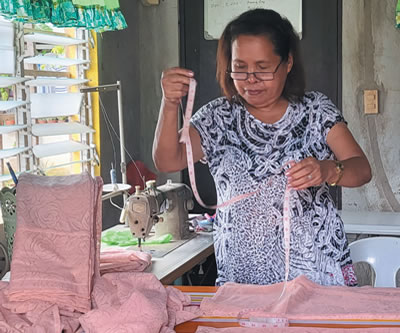
The first super typhoon, Sendong (international name: Washi), tore over Cagayan de Oro (CDO), Iligan City, and certain areas of Lanao del Norte in December 2011. Houses were destroyed, infrastructure was damaged, and a number of people were killed. As a result, a number of families from CDO and other Misamis Oriental municipalities had to relocate to new locations, one of which is the Divine Mercy Village, which is located in Barangay Patag, Opol, Misamis Oriental. Various humanitarian groups and religious congregations helped set up the new village and provided in-kind support interventions, the majority of which stopped in five years due to resource depletion.
Fourteen years later, the Columban missionaries have kept up their accompanying commitment, particularly for women and young people. Columban support also facilitated direct support to ten families, and with those whose members are hospitalized, whose students were problematic as regards their educational needs, and those living in unfavorable situations. The community has been working with Columban lay missionary Ana Flores, a Peruvian by birth.
Ten (10) women participated in a bag-making workshop on January 15, 2015. Starting was challenging, especially since they lacked a location where they could carry on their livelihood activities. Fortunately, one of the houses was shared by one of the village officers, and it is still being used for the program.
A number of women indicated interest in joining the organization, but finding supplies or materials and sewing machines for them was a challenge. Marketing of the women’s products was likewise a complete nightmare.
The sewing effort was briefly suspended during the height of the COVID-19 pandemic. It was reopened with more members in June 2022. It is regrettable that the sewing machines’ damage occurred so quickly that repairs were required. And despite repairs, three machines recently failed. The trained women also desired to produce t-shirts and jogging bottoms, noting the necessity for a new type of machine as well as training sessions in skill development for the new members. In addition, marketing strategies need to be explored.
What have been the biggest successes (thus far) of the project/ program?
A breakthrough was made after seven years of working on the project. The women frequently had no customers, no materials, malfunctioning equipment that hadn’t been fixed, and members who had decided to stop working, but the majority persisted. The largest accomplishment is having a small daily income; that really benefited each household. Also, women’s sewing abilities have improved to include making ethnic clothing, curtains, blouses, togas and graduation gowns, band uniforms, party costumes, bedsheets, sala set coverings, rags, and foot mats.
Has there been any radical revisioning of the project/program since it started to better serve the needs of people?
The project’s initial goal was to assist each family of women members with basic needs including food, daily transportation for the children who were attending school and parents working outside the village, as well as defray expenses for water and electricity bills. As the years passed, the demand for more sewing machines and supplies gradually became an issue as more and more women joined. This development pushed for the revisioning of the project.
The women subsequently held meetings to discuss how to further raise the caliber of their output, how to handle all neighborhood sewing-related needs, and how to make sure that the women members would personally profit from their labor. One of the top priorities they thought about is increasing the viability of their sewing project, improving quality of their products, and ensuring higher demand for their items.
Since this is a small enterprise with a local focus rather than just a livelihood project, it was necessary for the women to familiarize themselves with the idea even more. In order to increase collaboration with the Department of Labor and Employment (DOLE), TESDA, and DTI, the women must be more practical in their planning and resource mobilization.
Who provides oversight into the day-to-day operation? Is there any independent governance like a board, or committee?
The organization has complied with the Cooperative Code of the Philippines’ requirements for the typical organizational structure. The officers oversee managing the membership, and committees have been established to handle the numerous organizational issues. Columban lay missionary Ana Flores also assists the group in carrying out daily tasks.
This is a local project that deals with the real, immediate problems that women and their families are facing. Being forced to relocate is difficult, and it is never simple to find the will to live again while everyone is still reeling from the trauma. Along with being a source of income, this also aids in stress relief or trauma healing. As this goes on, it is also good to link up the role of women in the promotion and protection of the environment.
The Columban missionaries’ charism of promoting economic justice is in line with this.
How much funding is required to run the project/program on an annual basis? What is the breakdown of the costs (salaries, materials, food, etc.)?
Is there a possibility that the project/program will be locally funded once it is established? Will it become self-sustaining and is that an objective.
This campaign is expected to continue. Members who are financially literate will also aid the other women members in managing their incomes more effectively. Given a regular market and the ability to enhance their output, this will eventually transform the organization into one that is self-sustaining and self-nourishing, meaning they will rely entirely on their own resources instead of any outside assistance.
Columban lay missionary Ana Flores lives and works in the Philippines.